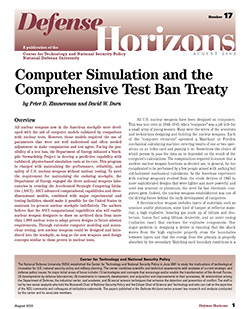Overview
 All nuclear weapons now in the American stockpile were developed with the aid of computer models validated by comparison with nuclear tests. However, those models required the use of parameters that were not well understood and often needed adjustment to make computation and test agree. Facing the possibility of a test ban, the Department of Energy initiated a Stockpile Stewardship Project to develop a predictive capability with validated, physics-based simulation tools at its core. This program is charged with maintaining the performance, reliability, and safety of U.S. nuclear weapons without nuclear testing. To meet the requirement for maintaining the enduring stockpile, the Department of Energy engaged the three national weapons laboratories in creating the Accelerated Strategic Computing Initiative (ASCI). ASCI advanced computational capabilities and three-dimensional models, combined with major experimental and testing facilities, should make it possible for the United States to maintain its present nuclear stockpile indefinitely. The authors believe that the ASCI computational capabilities also will enable nuclear weapon designers to draw on archived data from more than 1,000 nuclear tests to adapt proven designs to future mission requirements. Through extensive computer modeling and nonnuclear testing, new nuclear weapons could be designed and introduced into the stockpile, so long as the new weapons used design concepts similar to those proven in nuclear tests.
All nuclear weapons now in the American stockpile were developed with the aid of computer models validated by comparison with nuclear tests. However, those models required the use of parameters that were not well understood and often needed adjustment to make computation and test agree. Facing the possibility of a test ban, the Department of Energy initiated a Stockpile Stewardship Project to develop a predictive capability with validated, physics-based simulation tools at its core. This program is charged with maintaining the performance, reliability, and safety of U.S. nuclear weapons without nuclear testing. To meet the requirement for maintaining the enduring stockpile, the Department of Energy engaged the three national weapons laboratories in creating the Accelerated Strategic Computing Initiative (ASCI). ASCI advanced computational capabilities and three-dimensional models, combined with major experimental and testing facilities, should make it possible for the United States to maintain its present nuclear stockpile indefinitely. The authors believe that the ASCI computational capabilities also will enable nuclear weapon designers to draw on archived data from more than 1,000 nuclear tests to adapt proven designs to future mission requirements. Through extensive computer modeling and nonnuclear testing, new nuclear weapons could be designed and introduced into the stockpile, so long as the new weapons used design concepts similar to those proven in nuclear tests.
READ MORE >>